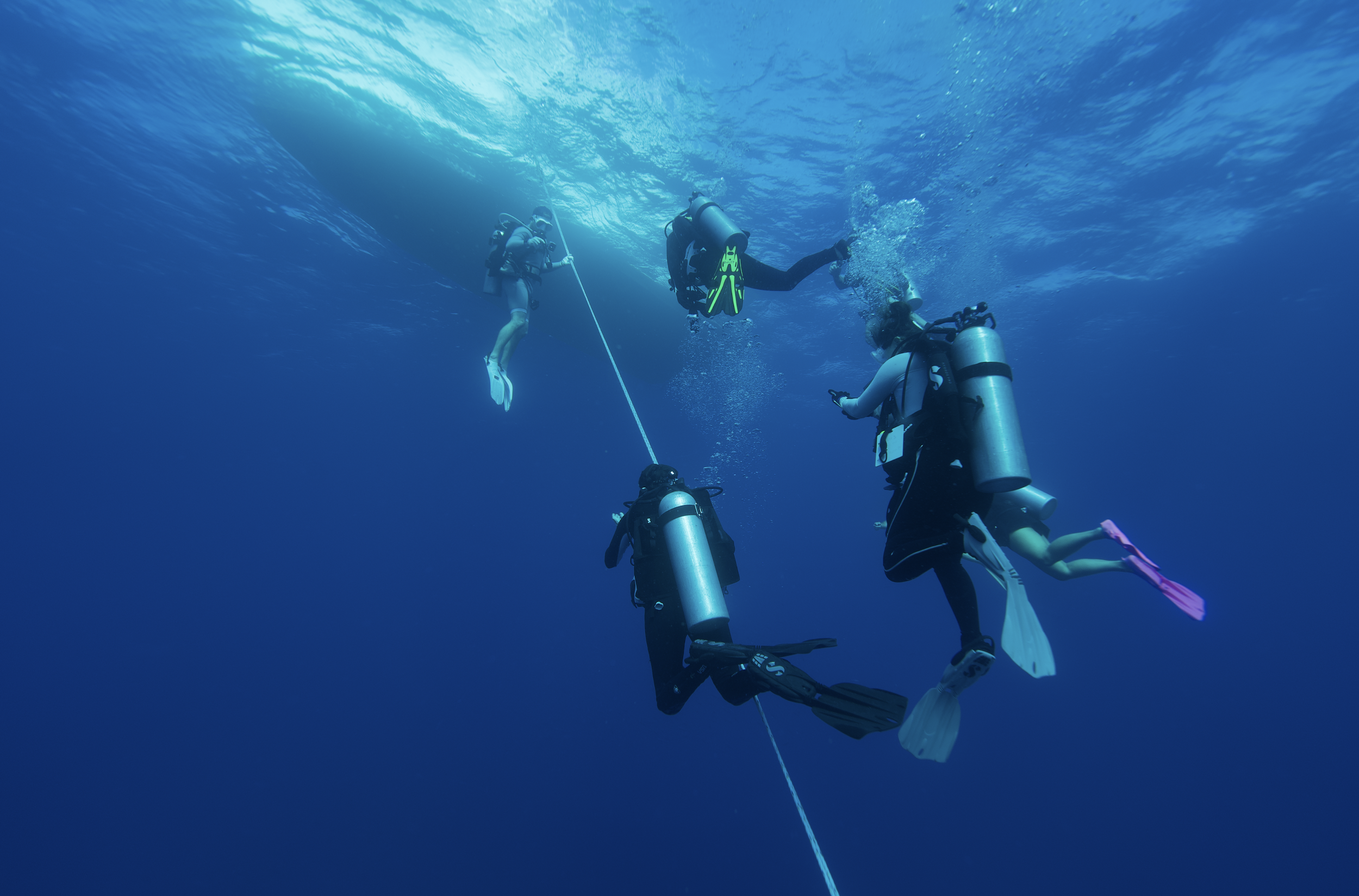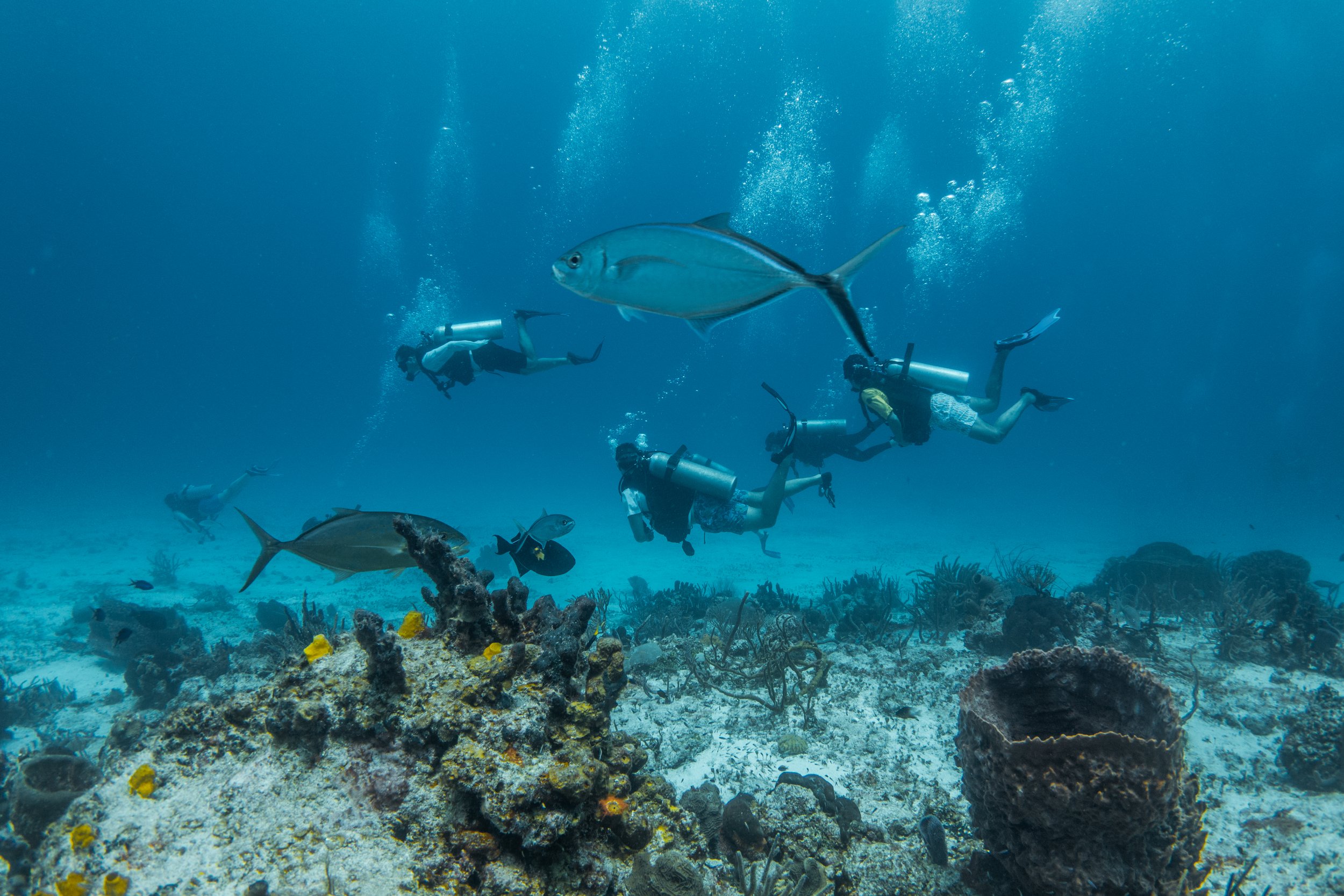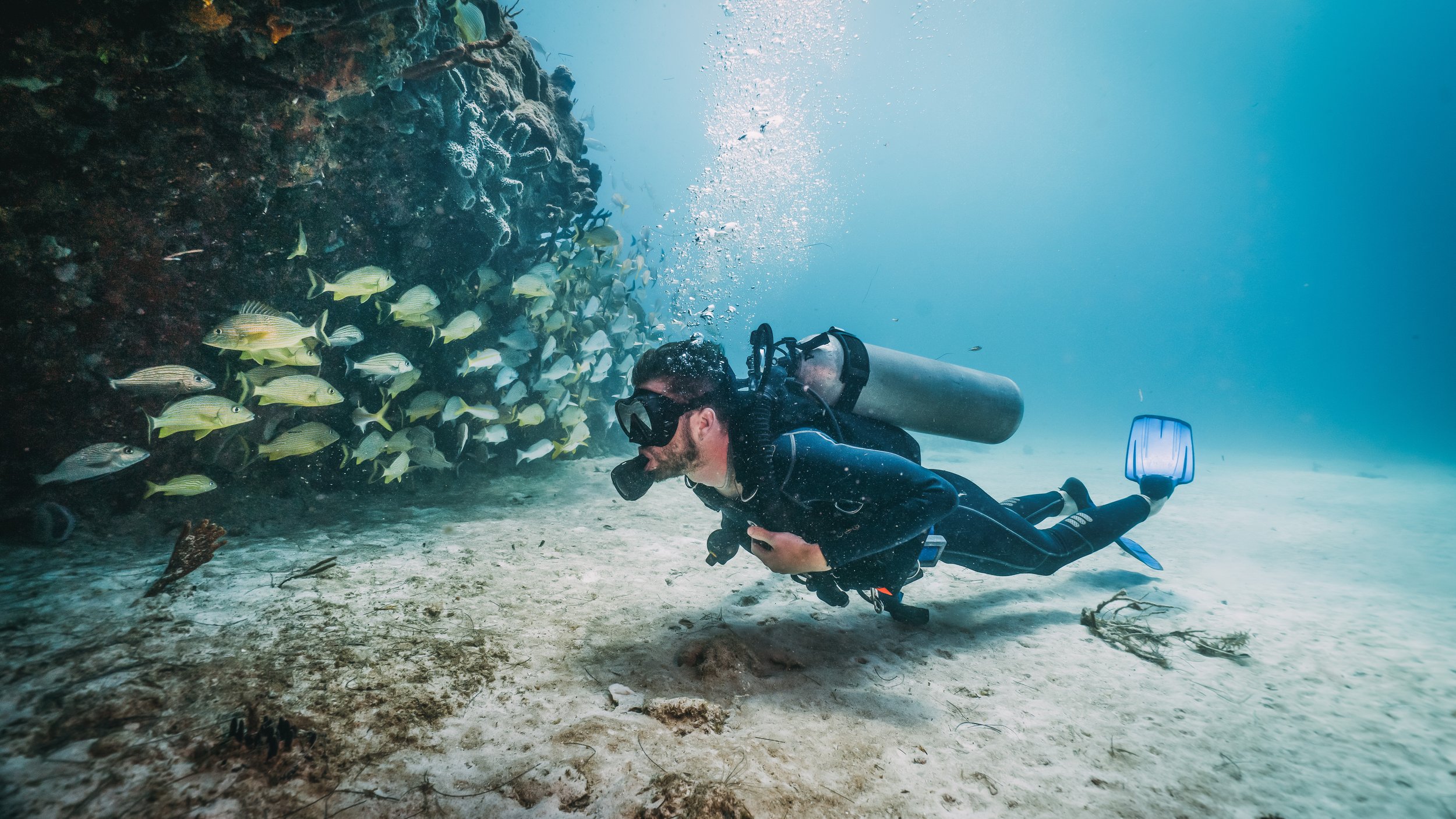Explore Oahu Scuba Diving Sites
Wreck & Reef Dives
Morning Advanced 2-Tank Dive (7AM):
Wreck dive at one of Oahu’s many sites.
Reef dive at a shallow, vibrant coral reef.
Perfect for advanced divers looking for a deeper experience.
Midday and Afternoon Dives (11AM & 2:30PM):
Dive sites selected daily based on ocean conditions.
Potential locations include coral reefs and wrecks.
Pricing:
Certified Divers (Ages 15+): $231
Riders (Ages 16+): $99
What to Expect:
Access to top Oahu scuba diving sites with diverse marine life.
Optional Nitrox for easier breathing and extended dive times.
Safe and comfortable rides aboard our best-in-class boats.
We operate daily and welcome divers of all experience levels. Our experienced crew ensures a safe and enjoyable time in Oahu’s waters.
Join us for an unforgettable underwater experience in the vibrant waters of Honolulu where you’ll find the best scuba diving in Hawaii . Dive Oahu offers daily trips aboard our 46' Newton Dive Special boats, known for their stability, comfort, and spacious layout. Designed with divers in mind, these boats provide a smooth ride, ample room for gear, and comfortable seating for both divers and riders.
Whether you’re an advanced diver seeking new challenges or a beginner looking to explore Oahu’s stunning reefs, our dive charters cater to all skill levels. With a range of dive sites and flexible scheduling, we ensure a safe, enjoyable, and memorable experience for everyone on board
Explore The Wreck & Reef Dive Locations
Wreck Dives
Sea Tiger
The Sea Tiger wreck is one of Dive Oahu’s favorites! It lies in about 127 feet of sand, with the main deck between 85 and 100 feet. The Sea Tiger sits perfectly upright and over the years has begun to deteriorate with railings falling into the sand and sharp exposed pieces of metal sticking out. She was sunk in 1999 as an artificial reef by Voyager Submarine who shortly after went out of business leaving it for SCUBA Divers to enjoy!
The story goes, that she, known at the time as Yun Fong Seong No. 303, was found smuggling undocumented Chinese immigrants, so the five crew-members were sent to prison. In 1994 it was sold to a Vietnamese fisherman who renamed her Sea Tiger but abandoned her to Honolulu Harbor after repeated fines. That is when Voyager Submarine bought her for $1 but spent thousands of dollars and time with paperwork and gutting her to be environmentally ready to sink.
She is now home to several resident undulated, yellow margin, and dwarf morays. If you’re lucky, you may catch a glimpse of the resident java moray, the largest of them all! Octopus love to hang out in the floorboards, white tip reef sharks will sleep underneath or inside the wreck, and always look out for eagle rays flying high or broad stingrays cruising in the sand. Lots of our reef fish enjoy hanging out in and around the wreck as well, including schooling pennant butterfly fish!
YO-257 &
San Pedro
These two wrecks are lying side by side attracting all sorts of marine life, including the Atlantis Submarine and the thousands of visitors inside each day! The YO is an old Navy Yard Oiler which would deliver thousands of gallons of fuel to other ships during World War II as well as the Korean War. She was sunk in 1989 by Atlantis Submarine as an artificial reef.
Just over 100 feet away, lies another wreck that was also sunk by Atlantis Submarine in 1996. San Pedro was owned by an old Korean Fishing Company. In 1997 she was carrying supplies and caught fire! The ship was then towed to Keehi Lagoon where it sat anchored for nearly 20 years before being sunk. When conditions and current are right, our divers will have a chance to dive both wrecks in the same dive!
It is common to see several turtles, eagle rays, and even sharks lying inside of the San Pedro! Look out for lots of nudibranchs, leaf scorpion fish and frog fish on the YO. The YO offers some beautiful swim throughs which make for great photos as well!
Navy Tug
Nashua, aka the Navy Tug, gets its name because it continues to be an active training site for the US Navy. It sits in 65 feet of rocky sand on large steel pillars. If you look underneath the wreck, you might be greeted by white tip reef sharks and schooling blue stripe snapper. Often times there will be large schools of mackerel scad “bait balls” which you can expect to see some of our larger trevaly, amber jacks, rainbow runners.
Corsair
The Corsair turned out to be a beautiful mistake when the plane went down during a training exercise from Pearl Harbor in 1948. The pilot noticed the needle on the fuel gauge dropping, but continued to fly thinking it was defective. Soon after, the plane began falling and the pilot was able to perform a perfect water landing -he survived! The plane lies in 105 feet of sand surrounded by fields of garden eels. Large morays, leaf scorpionfish, and frog fish are commonly found at this site.
Landing Craft Utility
The Landing Craft Utility (LCU) wreck lies at 85 feet and is a former military vessel used to transport troops and equipment. Now an artificial reef, it hosts a variety of marine species such as octopuses, moray eels, and parrotfish. Its accessible interior and the presence of larger pelagic fish make it a popular spot for underwater exploration.
Mahi
The Mahi wreck is a 185-foot former navy minesweeper resting at a depth of 90 feet off the coast of Oahu. It offers divers an opportunity to explore its structure teeming with marine life, including schools of goatfish, eagle rays, and occasional sightings of dolphins. The wreck's open spaces and easy penetration points make it an exciting site for advanced divers.
Reef Dives
Ewa Pinnacles
Ewa Pinnacles features lava formations from 100 to 60 feet, teeming with macro life, turtles, sharks, and rays. Highlights include garden eels, orange cup coral, and bi-color anthias. Dive with Dive Oahu for an unforgettable experience.
Keehi Pipe aka Mario World
Keehi Pipe is another storm drain, but gets the name “Mario World” for the several vertical outcroppings coming up from the horizontal pipe. Peak down inside and you will see schooling squirrel fish and maybe even a shark or large moray eel. Mario World is one of the only places we see schooling puffer fish! Check out the sandy bottom for freckled snake eels poking their heads out and juvenile peacock razor wrasse hovering above the sand.
Turtle Canyon
Turtle Canyon is a finger reef system divided by sandy bottoms between each of the reefs. One of the canyons in particular is known for the Hawaiian green sea turtles (Honu) that consistently frequent the reef to get their shells cleaned. Commonly, the endemic gold ring surgeon fish can be seen snacking on/cleaning the algae off of their shells and bodies. If you can peel yourself away from the turtle station, this site offers a range of reef fish and sometimes will even surprise us with our more rare fish like saddleback butterflies or flame angels!
Horseshoe Reef
Horseshoe Reef gets its name from two horse shoe shaped reefs sitting back to back, similar to an UnderArmor symbol. This reef is a great place witness the different phases and color variations that wrasse go through throughout their life cycle like the yellowtail coris and rock-mover wrasse. If you peak under the side ledges, it is common to see the Sergeant Major protecting their eggs which are easy to identify by their bright purple color. During our night dives, you may even have a chance to see the elusive dragon moray! A short swim to the east is another reef we call Secret Reef which is known for the small turtle cleaning station cove at the end and also a great place to find white tip reef sharks sleeping.
Kewalo Pipe Reef
The largest of our dive sites with surrounding garden coral fields and finger reefs both east and west. Kewalo Pipe is an old storm drain that has become host to a variety of coral and marine life. The end of the pipe lies at 60 feet where you can often times see a resident yellow margin moray eel or two. School heller’s barracuda, devil’s scorpion and leaf scorpion fish are also common, as well as several species of nudibranchs and flatworms. Throughout the dive, keep your eyes out for other common eels, beautiful butterfly fish, colorful wrasse and our pygmy angelfish!
Nautilus Reef
Nautilus Reef is known primarily for being two large finger reefs sitting next to each other. However, there are several more fingers both east and west from the main moorings. The east side of reef is home to small white tip reef sharks that are commonly seen napping in the darkness of the ledge. Throughout other parts of the ledge you may find schools of red squirrel fish as well as blue striped snappers. The reefs host several friendly millet-seed butterfly and saddle wrasse which are both endemic to Hawai`i. You may even see them following you throughout your entire dive! Keep your eyes out for the sea urchins so you don’t get poked!
Frequently Asked Questions
About Our Oahu Reef and Wreck Dives
-
Oahu is fantastic for scuba diving, with dive sites near Waikiki that are easily accessible by boat. The area offers something for all skill levels, including beginner dives, deep dives, and wreck dives. Whether you're new to diving or an experienced diver, you'll find plenty of options to explore Oahu’s underwater beauty.
-
The best months to dive in Oahu are during the summer (June to September) when water temperatures range from 77-80°F, peaking in September. These warm, calm conditions make it an ideal time for diving. However, Oahu offers excellent scuba diving year-round, with mild weather and great underwater visibility in most months.
-
Wetsuits are optional when scuba diving in Hawaii due to the island's warm waters. Many divers are comfortable without one, but some may prefer a wetsuit for added comfort, especially during longer dives or in deeper waters where it can feel cooler.
-
In Hawaii, recreational scuba diving typically ranges from 100 to 130 feet for advanced dives. At these depths, divers can explore more remote and deeper environments where larger marine species are often found. However, dive depth may vary depending on the site and diver certification level.
-
For beginner divers, the maximum depth is typically around 40 feet (12 meters). During training, your first dives will be in shallow waters, with the possibility of diving up to 60 feet (18 meters) on more advanced dives as you progress through certification.













